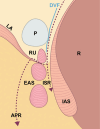Essential knowledge and technical tips for total mesorectal excision and related procedures for rectal cancer
- PMID: 39228201
- PMCID: PMC11375228
- DOI: 10.3393/ac.2024.00388.0055
Essential knowledge and technical tips for total mesorectal excision and related procedures for rectal cancer
Abstract
Total mesorectal excision (TME) has greatly improved rectal cancer surgery outcomes by reducing local recurrence and enhancing patient survival. This review outlines essential knowledge and techniques for performing TME. TME emphasizes the complete resection of the mesorectum along embryologic planes to minimize recurrence. Key anatomical insights include understanding the rectal proper fascia, Denonvilliers fascia, rectosacral fascia, and the pelvic autonomic nerves. Technical tips cover a step-by-step approach to pelvic dissection, the Gate approach, and tailored excision of Denonvilliers fascia, focusing on preserving pelvic autonomic nerves and ensuring negative circumferential resection margins. In Korea, TME has led to significant improvements in local recurrence rates and survival with well-adopted multidisciplinary approaches. Surgical techniques of TME have been optimized and standardized over several decades in Korea, and minimally invasive surgery for TME has been rapidly and successfully adopted. The review emphasizes the need for continuous research on tumor biology and precise surgical techniques to further improve rectal cancer management. The ultimate goal of TME is to achieve curative resection and function preservation, thereby enhancing the patient's quality of life. Accurate TME, multidisciplinary-based neoadjuvant therapy, refined sphincter-preserving techniques, and ongoing tumor research are essential for optimal treatment outcomes.
Keywords: Pelvic anatomy; Rectal cancer; Total mesorectal excision.
Conflict of interest statement
Nam Kyu Kim is an Editor-in-Chief Emeritus of
Figures






















References
-
- Ferlay J, Ervik M, Lam F, Colombet M, Mery L, Piñeros M, et al. International Agency for Research on Cancer (IARC); Global cancer observatory: cancer today [Internet] [cited 2024 Jun 3]. Available from: https://gco.iarc.who.int/today/en.
-
- Siegel RL, Miller KD, Jemal A. Cancer statistics, 2019. CA Cancer J Clin. 2019;69:7–34. - PubMed
-
- Heald RJ, Husband EM, Ryall RD. The mesorectum in rectal cancer surgery: the clue to pelvic recurrence? Br J Surg. 1982;69:613–6. - PubMed
Publication types
LinkOut - more resources
Full Text Sources

